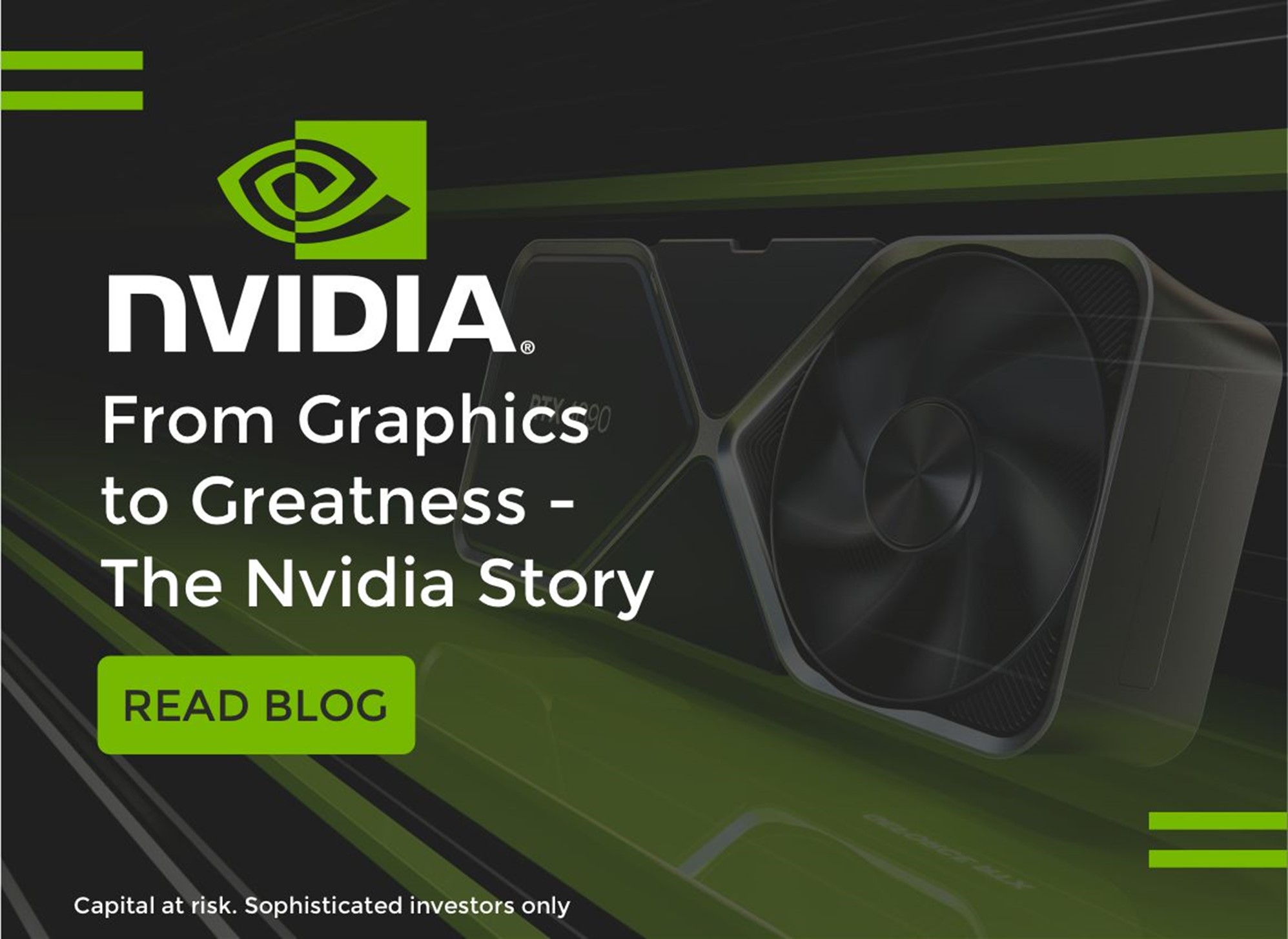From Graphics to Greatness - The Nvidia Story
Posted:
Nvidia Corporation, founded in 1993, has profoundly transformed the tech industry, evolving from a niche graphics card manufacturer into a global technology powerhouse. Initially revolutionizing the gaming industry with its powerful graphics processing units (GPUs), Nvidia's influence now extends far beyond gaming, encompassing artificial intelligence (AI), data centers, autonomous vehicles, and professional visualization.
This journey from graphics to greatness is a testament to Nvidia's visionary leadership, relentless innovation, and strategic foresight, culminating in its meteoric rise to become the most valuable company in the world by mid-2024, a milestone that market historians will analyze for years to come.
Early History
Nvidia Corporation was founded in 1993 by Jensen Huang, Chris Malachowsky, and Curtis Priem, three engineers with a vision to create a company that would redefine computing graphics. They saw an opportunity in the burgeoning field of computer graphics and aimed to build a powerful graphics chip that could handle the increasing demands of video games and multimedia applications.
The company's first major product was the NV1, a multimedia accelerator that combined 2D and 3D graphics. Although it wasn't a commercial success, the NV1 laid the foundation for Nvidia's future innovations. Learning from this initial setback, Nvidia introduced the RIVA series in the late 1990s, which gained traction in the market and established Nvidia as a key player in the graphics industry.
The true breakthrough came in 1999 with the release of the GeForce 256, the world’s first GPU (Graphics Processing Unit). The GeForce 256 revolutionized the gaming industry with its ability to handle complex graphics rendering tasks independently of the CPU, delivering unprecedented performance and visual quality. This innovation set the stage for Nvidia's dominance in the gaming graphics market.
Nvidia's early years were marked by rapid growth and innovation. The company went public in 1999, just as the dot-com bubble was nearing its peak, and successfully navigated the subsequent market downturn. By continuously pushing the boundaries of graphics technology, Nvidia built a solid foundation that would support its expansion into new markets and applications in the years to come.
Breakthrough with GPUs
Nvidia's breakthrough came with the release of the GeForce 256 in 1999, which introduced the concept of the GPU (Graphics Processing Unit). This innovation, capable of processing a vast number of parallel operations, dramatically improved graphics rendering performance and set a new standard in the gaming industry, establishing Nvidia as a leader in graphics technology.
The GeForce 256 featured transform and lighting (T&L) hardware acceleration, allowing for more realistic and complex 3D graphics in games. Its success paved the way for subsequent generations of GPUs, such as the GeForce 2 in 2000 and the GeForce 3 in 2001, the latter introducing programmable shaders that enhanced visual effects in games. Nvidia's GPUs soon expanded beyond gaming into professional visualization, scientific computing, and artificial intelligence (AI).
The CUDA platform, introduced in 2006, leveraged GPU parallel processing for general-purpose computing, opening new possibilities in fields like medical imaging, fluid dynamics, and deep learning. These advancements transformed Nvidia from a niche graphics player into a key driver of innovation across multiple industries, laying the groundwork for its future growth and diversification.
Expansion and Diversification
Following its breakthrough with GPUs, Nvidia strategically expanded and diversified its offerings, targeting new markets beyond gaming and solidifying its position as a leader in graphics technology and other high-growth industries.
Professional Visualization and Design:
Nvidia extended its GPU technology to professional visualization with the Quadro series, designed for fields like computer-aided design (CAD), digital content creation, and scientific visualization. Quadro GPUs became the preferred choice for demanding professional applications due to their precision, power, and reliability.
High-Performance Computing and Data Centers:
Nvidia entered the high-performance computing (HPC) market with the Tesla series, optimized for parallel computing and used in supercomputers, data centers, and research institutions. The CUDA platform enabled GPU acceleration for scientific and engineering applications, significantly speeding up computational tasks.
Artificial Intelligence and Machine Learning:
Nvidia expanded into AI and machine learning, with GPUs well-suited for AI workloads due to their parallel processing capabilities. The Volta and Ampere architectures, with specialized Tensor Cores for deep learning, positioned Nvidia at the forefront of AI research. Nvidia GPUs became the standard for training deep neural networks, powering advancements in natural language processing, computer vision, and autonomous systems.
Autonomous Vehicles:
Nvidia developed the Nvidia DRIVE platform for autonomous driving, integrating AI, sensor fusion, and deep learning. This platform enabled vehicles to perceive and navigate complex environments, with partnerships with major automotive manufacturers and technology companies contributing to the development of self-driving cars and advanced driver-assistance systems (ADAS).
Strategic Acquisitions:
To bolster its technological capabilities and market reach, Nvidia made several strategic acquisitions, including Mellanox Technologies in 2019, enhancing its data center offerings. The planned acquisition of Arm Holdings aims to expand Nvidia's influence in the mobile and embedded systems markets.
Broader Ecosystem and Partnerships:
Nvidia built a broad ecosystem through strategic partnerships with tech firms like Google, Microsoft, and Amazon, integrating its GPUs into cloud services. Nvidia’s GPUs are also used in industries such as healthcare and finance for advanced analytics and simulation tasks.
Rise in the AI and Data Center Markets
Nvidia's rise in the AI and data center markets is a significant chapter in its history, leveraging its GPU technology to drive innovation and expand its market reach.
Transition to Artificial Intelligence:
Nvidia recognized early on that GPUs were ideal for AI workloads due to their parallel processing capabilities. The 2006 introduction of the CUDA platform was pivotal, enabling developers to harness GPU power for general-purpose computing and AI.
Volta and Ampere Architectures:
In 2017, Nvidia launched the Volta architecture with the Tesla V100 GPU, featuring Tensor Cores optimized for deep learning, significantly boosting AI performance. The 2020 Ampere architecture, with the A100 GPU, further enhanced AI performance, setting a new standard for AI computing and driving Nvidia’s growth in the AI market.
Dominance in Data Centers:
Nvidia’s GPUs are integral to modern data centers, which are crucial for cloud computing and AI services. The acquisition of Mellanox Technologies in 2019 strengthened Nvidia’s data center offerings by integrating high-performance networking solutions with its GPU technology, delivering exceptional performance for large-scale AI and HPC deployments.
Strategic Partnerships and Ecosystem Development:
Nvidia has formed strategic partnerships with leading tech companies like AWS, Microsoft Azure, and Google Cloud to expand its reach in the AI and data center markets. Initiatives like the Nvidia Deep Learning Institute and the Nvidia Inception program foster a community of developers and innovators who rely on Nvidia’s technology for AI research and application.
AI Software and Platforms:
Nvidia’s software platforms, including CUDA, cuDNN, and TensorRT, simplify AI model development and deployment, fully utilizing Nvidia’s GPUs. The Nvidia GPU Cloud (NGC) offers optimized AI frameworks and pre-trained models, making AI resources more accessible and accelerating AI adoption across industries.
Data Centers and Cloud Computing
Nvidia has become a pivotal player in the data center and cloud computing markets by providing powerful GPUs that significantly accelerate processing speeds for complex computations. Their GPUs are essential in enabling big data analytics, artificial intelligence (AI), and machine learning tasks that require immense computational power. Nvidia's collaborations with leading cloud service providers, such as Amazon Web Services, Google Cloud, and Microsoft Azure, have further solidified their presence in this space.
These partnerships allow organizations to leverage Nvidia's advanced GPUs through cloud platforms, thereby enhancing performance and efficiency in various applications, from scientific research to financial modeling. By continually innovating and expanding their GPU capabilities, Nvidia has positioned itself as a leader in the data center and cloud computing sectors, driving the next generation of technological advancements.
Strategic Acquisitions
To bolster its technological capabilities and expand its market reach, Nvidia made several strategic acquisitions that significantly enhanced its offerings and competitive position.
Mellanox Technologies (2019):
One of Nvidia's most notable acquisitions was Mellanox Technologies, a leading provider of high-performance networking solutions. This acquisition integrated Mellanox’s advanced networking technology with Nvidia’s GPUs, delivering comprehensive solutions for AI and high-performance computing (HPC). The synergy between Nvidia’s GPUs and Mellanox’s networking products enabled the development of more efficient and powerful data center solutions, addressing the growing demands of AI and data-intensive applications.
Arm Holdings:
Nvidia announced plans to acquire Arm Holdings, a major designer of microprocessors. If completed, this acquisition would give Nvidia control over a vast array of intellectual property and expand its influence in the mobile and embedded systems markets. Arm’s technology is widely used in smartphones, tablets, and other devices, and this acquisition would provide Nvidia with a strong foothold in these markets, potentially enabling new innovations in AI and computing.
Other Acquisitions:
Nvidia also pursued smaller acquisitions to enhance its technological portfolio and market reach. These acquisitions targeted companies with expertise in areas such as AI, deep learning, and high-performance computing, helping Nvidia to stay at the forefront of technological advancements and maintain its competitive edge.
These strategic acquisitions have played a crucial role in Nvidia's growth, enabling it to offer integrated solutions that combine advanced computing and networking capabilities. By acquiring companies with complementary technologies, Nvidia has strengthened its position in key markets and expanded its ability to innovate and meet the demands of the rapidly evolving tech landscape.
Stock Market Performance
Nvidia's stock market performance has been remarkable, reflecting its leadership in technology and consistent innovation. As of mid-2024, Nvidia (NASDAQ: NVDA) has emerged as one of the most valuable companies globally by market capitalization. On June 18th, 2024, Shares of the chipmaker surged 3.6%, elevating its market cap to $3.34 trillion and surpassing Microsoft, now valued at $3.32 trillion.
Earlier this month, Nvidia reached $3 trillion for the first time and also surpassed Apple. The rise in Nvidia's market value has been fueled by the increasing demand for its chips, which are considered the leading choice in the AI sector, and investing in the future of AI-focused companies. The company's shares have surged over 170% this year and have soared approximately 1,100% since hitting a low point in October 2022.
The company's stock has surged significantly, driven by strong growth in its core markets of gaming GPUs, data center solutions, and expansion into AI and autonomous vehicles. Investor confidence in Nvidia's strategic acquisitions, such as Mellanox Technologies in 2019, and its pivotal role in powering AI advancements has further bolstered its stock performance. Nvidia continues to be a key player in shaping the future of computing, driving substantial returns for its shareholders amidst evolving technological landscapes.
Nvidia's Five Year's Quarterly Revenue by Segment
Nvidia serves five main markets: data center, gaming, professional visualization, automotive, and original equipment manufacturer (OEM) and others.

Conclusion
Nvidia's transformation from a niche graphics card manufacturer to a global technology leader is a testament to its visionary leadership, relentless innovation, and strategic foresight. By revolutionizing the gaming industry with groundbreaking GPUs and expanding into high-growth markets like AI, data centers, and autonomous vehicles, Nvidia has consistently pushed the boundaries of technological advancement.
Strategic acquisitions and collaborations have further strengthened its market position, culminating in its rise to become the most valuable company in the world by mid-2024. Nvidia's journey from graphics to greatness underscores its pivotal role in shaping the future of computing and driving the next generation of technological innovations.
NVIDIA ETPs by GraniteShares
| Product name | Ticker | ||
|---|---|---|---|
| USD | EUR | GBX | |
DISCLAIMER
This is a disclaimer stating that all trading and investing comes with risks. Always do your research and do not invest more than you can afford to spend. GraniteShares accepts no responsibility for any loss or damage resulting directly or indirectly from the use of this blog or the contents.
This blog does not constitute an offer to buy or sell or a solicitation of an offer to buy securities in any company. Nothing contained herein constitutes investment, legal, tax or other advice nor is to be relied upon in making an investment or other decision. No recommendation is made positive or otherwise, regarding individual securities or investments mentioned herein. Any summary list of risk factors does not purport to be a complete enumeration or explanation of the risks involved in a particular investment. Prospective clients must consult with their own legal, tax and financial advisers before deciding to invest. This email contains the opinions of the author and such opinions are subject to change without notice. The source of data is GraniteShares unless otherwise stated. No guarantee is made to the accuracy of the information provided which has been obtained from sources believed to be reliable. This email and the information contained herein is intended only for the use of persons (or entities they represent) to whom it has been provided. Past performance is not a reliable indicator of future results. The value of an investment may go down as well as up and can result in losses, up to and including a total loss of the amount initially invested. Investments may involve numerous risks including, among others, company risks, general market risks, credit risks, foreign exchange risks, interest rate risks, geopolitical risks and liquidity risks. Please note that GraniteShares short and leveraged Exchange Traded Products are for sophisticated investors.
GraniteShares Limited is contracted by GraniteShares Jersey Limited to provide operating and marketing services.

GraniteShares
GraniteShares

